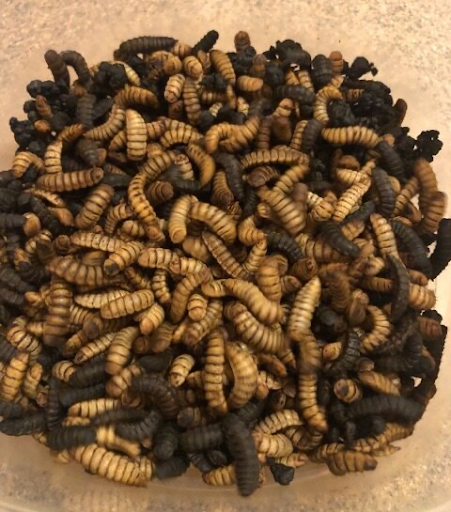
October 2021 Newsletter
Published October 1st at 10:00am PST
“All along the meandering tributary there are signs of man's peaceful coexistence with nature: a small log cabin, grazing sheep, children playing on a bridge, and cows standing placidly in the water. Here, man neither conquers nor is subservient to nature; both coexist harmoniously.” -National Gallery of Art
Fun Fact: Cropsey painted this from memory!
Table of Contents
Critters in My Compost
Creepy Crawlers
October Astrological Events
D.I.Y. Costumes
Why We Will All Buy Unsustainably and What We Can Do to Stop Ourselves.
Cozy Up to Fall Sustainably
Tea for the Season
CRITTERS IN MY COMPOST
CRITTER CORNER
By Preston Brunk
What do you do with your vegetable scraps and paper products? Some might throw theirs in the trash, some might feed the scraps to their animals and recycle the paper, and some might put it in their compost or worm bin. Growing up on a farm we would give the kitchen scraps to our chickens or to our pigs and goats and we would throw away our paper products. It wasn't until I moved to college and became surrounded with more sustainably aware people that I began composting my kitchen scraps and paper products to use as compost for my garden. Composting is the act of making vegetative and/or manure into compost (Oxford Languages). Compost is a mixture of different organic materials that fertilize and improve the overall quality of the soil. “The resulting compost mixture is rich in plant nutrients and beneficial organisms, such as worms and fungal mycelium.”₁Composting is a great way to reduce the amount of waste that goes into our landfills and waste facilities every year while also benefiting the overall quality of the ecosystem.
In the past I have taken my scraps and dumped them in a spot where animals like my dog couldn't get into the mess of rotting and decomposing vegetables. I would keep adding to this pile for quite some time until it was a considerable size and then I would start a new pile. As I added to the new pile I would then turn the old pile and I would start to see decomposers such as fly maggots, earthworms, centipedes, beetles and the one that I was most interested in, the Black Soldier Larvae. I never noticed the Black Soldier Larvae (BSL) until I started a worm farm in one of those kits with the several levels you stack on top of one another. The BSL looks like something from a horror film. Quite similar looking to maggots, BSL are a little bigger, averaging around ⅞ of an inch and appear a little flatter. They also range in colors from yellow to black depending on where they are at in their life cycle. I was instantly fascinated by these larvae for a couple reasons. One, because they consumed the pack of earthworms and red worms that I introduced to my farm, and two, there were so many variations that I haven't seen with many other species.
Looking something like fish bait, I looked up the benefits of having these larvae in my bins besides as potential trout bait. It turns out that they are a great fertilizer for your crops and other plants. You can grow these larvae rather quickly and before they emerge as flies you expose them to light and then begin to dry out. From that point you can grind them up and spread them throughout your garden. These larvae are actually so efficient at decomposing that they are able to eat twice their body weight everyday. It might sound a little crazy but you can actually eat these things. They are packed full of protein and other nutrients and their waste is sterile meaning you don't technically have to clean these before consuming, but I would just to be safe.
It is interesting to me that the current greenhouse gas emissions and climate change has resulted in people finding solutions to alternate forms of protein. As stated by Emanuel Skrobanja of Crickster “The BSF larva is exceptionally good at converting feed into food. You may use 10 kg of feed to make 1 kg of beef and 2 kg of feed to make 1 kg of mealworms.” BSL also feeds off of waste that would either go to a landfill or to a compost facility and they can also feast on manure that would have to go through a treatment process. So BSL serve a great purpose for many different applications. They can serve as fertilizer for our crops, they promote the breakdown of vegetative matter as well as animal manure while cleaning up those soils of any diseases that may be present (their digestive process kills bacteria) and they can even serve as a primary protein source for some people as well as providing many other important nutrients.₂
Now you might be wondering what these larvae turn into. During their six instars, they begin to change from a pale yellow to a darger brown and sometimes black. Their development process starts with the female black soldier fly laying around 500 eggs pretty much anywhere that can sustain an egg for four days. From there, they become larvae and begin gorging themselves to survive and grow into a fly. Black soldier larvae are in this stage for 14 days during which they do nothing but move around and eat.₃ From larvae, they move to drier areas to become pupae.This is when they become dark brown and black. During the pupae stage which is about two weeks, the pupa is growing inside of the exoskeleton.₃ From there they emerge as flies and are either male or female and able to reproduce two days after emergence. During their breeding process the male will seize a female flying by and they “descend in copula”.₄ From there the life cycle of the fly ends and a new life begins for the eggs.
These native flies are found throughout the entire world (even Antarctica) but are most prevalent in the tropical/ subtropical Western Hemisphere as well as Australia.₅ They are much different than the common housefly. These black soldier flies are black like a house fly but take on the resemblance of a wasp however they do not sting or bite. Flies happen to be great pollinators for a variety of plants. They are also capable of consuming huge amounts of waste that other animals are not capable of. So the next time you see those black wasp looking flies or larger than average and flatter maggots, realize how important they are in the ecosystem and what they can do for your garden.
Works Cited:
“Compost.” Wikipedia. Wikimedia Foundation, September 19, 2021. https://en.wikipedia.org/wiki/Compost.
Skrobonja, Emanuel. “13 Reasons Why the Black Soldier Fly Is the Future of Food and Feed (2020.).” Crickster. Crickster, May 19, 2020. https://www.eatcrickster.com/blog/black-soldier-fly.
Hall DC, Gerhardt RR. 2002. Flies (Diptera), pp 127-161. In Mullen G, Durden L. (editors). Medical and Veterinary Entomology. Academic Press. San Diego, California.
Tomberlin JK, Sheppard DC. 2001. Lekking behavior of the black soldier fly (Diptera: Stratiomyidae). Florida Entomologist 84: 729-730.
Hawkinson, Candice. Beneficial insects in the landscape: #51 black soldier fly (Hermetia illucens). Accessed October 1, 2021. https://aggie-horticulture.tamu.edu/galveston/beneficials/beneficial-51_black_soldier_fly.htm.
Other Sources:
“Compost pile microbes”. California Department of Resources Recycling and Recovery (CalRecycle). Accessed September 20, 2021. https://www.calrecycle.ca.gov/organics/homecompost/microbes.
“Reducing the Impact of Wasted Food by Feeding the Soil and Composting.” EPA. Environmental Protection Agency. Accessed September 20, 2021. https://www.epa.gov/sustainable-management-food/reducing-impact-wasted-food-feeding-soil-and-composting.
Black soldier fly - hermetia illucens. University of Florida. Accessed September 20, 2021. https://entnemdept.ufl.edu/creatures/livestock/black_soldier_fly.htm.
CREEPY CRAWLERS
THE CREEPY CRAWLERS IN YOUR COMPOST
WEIRDEST CREEPY CRAWLY MOMENTS—BBC EARTH
OCTOBER ASTRONOMICAL EVENTS
ASTRO BOY
October 6: New Moon
October 7: Draconids Meteor Shower
October 20: Full Moon (Hunters Moon; Travel Moon; Blood Moon)
October 21, 22: Orionids Meteor Shower
October 25: Mercury at Greatest Western Elongation
October 29: Venus at Greatest Eastern Elongation
D.I.Y COSTUMES
CULTURE RADAR
If you’re taking part in costumed festivities this season, help out the planet and get creative! Dive deep into your closet, household items, or visit a secondhand store to piece together a unique costume! It’ll be one of a kind and a fun project. Invite your friends over and make your spooky fun eco-friendly! Here’s some ideas to get you started:
WHY WE BUY UNSUSTAINABLY AND WHAT WE CAN DO TO STOP OURSELVES.
NEURO NASH
By Alexandra Knight
‘Materialism is an identity crisis.’ - Bryant McGill.
We have all been shopping, seen something that we didn’t go out looking for, and purchased it. Later we question ourselves as to why we spent our money on it.
This happens not because of an item’s appealing brand logo or a product’s placement in a store, but because of an emotional response. Neuromarketing studies--an ethical study of the human brain through questionnaires, fMRI scans and other non invasive forms of examination-- have found that our emotions play a fundamental part in choosing what kind of items we buy and why we buy them.₁ Along with an emotional pull, everyone has some kind of cultural bias which is often rooted in tradition, upbringing and many other subconscious factors.
Many people do not often consider that these experiences will have an effect on their daily lives and choices; however, human beings are reward orientated. We are neurologically and biologically designed to be reward driven in our actions. Various studies have found that there are dopamine carrying and reward creating links in the human brain which run to and from four areas of the brain. These four areas deal with rewards and reward based behaviour, memory storage and flashbulb memories all of which are connected to our final behaviours and emotion responses to a situation, including our reactions to advertising stimuli.₁,₂
In shopping malls our senses are constantly bombarded with strategically designed colour palettes, nostalgic or feel good inducing, enticing scents and strategically placed signage that tries to promise us something interesting.₃,₄ This is exactly how companies convince us that we need to buy whatever they put in front of us - this mix of emotional persuasion and cultural trends leads us into perpetuated un-sustainable buying habits, which hurt humanity’s mental health and the wildlife which we highly admire and live alongside.₅ This is presented through developed conditions such as hoarding and mental over attachment to items.
A study conducted by an organisation called My Tool Shed suggests that the average piece of furniture generates around approximately 47 kilogrammes of carbon dioxide equivalents, which is roughly the same amount of greenhouse gases produced by burning around 5.3 gallons of petrol. Sofas rank as the highest polluters on the furnishing list as their foams and fillings make up to 40% of their 90 kilogram carbon dioxide equivalent emissions; contributing hugely to continual air pollution problems. One pair of running shoes creates 30lbs of carbon dioxide emissions during their manufacturing production as well as using various synthetic materials which are fossil fuel derived. Leather shoes use 3,626 gallons of water in their production. A smartphone uses Iron (20%) , aluminium (14%) and copper (7%) which will create metal pollution in waterways during the process of cleaning the materials, as well as causes deforestation in the Amazon rainforest as there are resources of gold lying deep under the forest floor which are used to create connectors in the phones wiring. Whilst these problems aren't due to us directly it is up to us to choose more sustainable manufacturers in order to set an example to the ones who aren't moving forward into an era of sustainability.₆₋₉
So how can we stop ourselves from harming humanity's long term prospects of blossoming with biodiversity whilst still remaining civilised in our ways of living?
Well, first we need to be aware of our emotions when shopping in these environments. It can be very hard to take emotional control of yourself in an environment that is tailored to fire all of your emotional responses, but it is not impossible. In order to better control our shopping habits we need to immediately observe what is happening around us. For instance - Is a song that we like playing whilst we are looking at something that is of interest to us? If this is the case, step back and ask yourself these questions:
Do I really have the room, space and money for this item? (Be honest with yourself. It will not be of any benefit to you if you aren’t.)
Where will it go in my house or apartment?
Will I regret buying this in a few weeks time? (Again, please be honest with yourself. It will be of no benefit to you in the long term if you aren’t continually honest.)
During this Q and A session with yourself, the feel good or nostalgic song in the background will still be trying to mentally persuade you by creating a false sense of assurance in your choice to buy the item. If you are still unsure of your choice to buy the item, put it down and leave it on the shelf. This helps to immediately keep your money firmly inside your pocket, as well as keep much needed space in your home.
You may be tempted to go back to look at it again, but if you are still unsure in any way never pick the item up and purchase it. When you do this you are kidding yourself into believing that you need something when you realistically do not.₅
Once you have done this for the first time you are going to be capable of doing it again. It will not take long to get into the habit of saying no to things that you are unsure of even when someone is trying to subconsciously influence you.
To finish this article I’d like to leave you with some tips which have been very beneficial to me personally when I am out shopping, a few of these I have discovered through personal experience..
Number one:
Stay away from shopping malls where and whenever you can - this helps you to avoid temptation as much as possible.
Number two:
If you do go into a store, don’t allow yourself to look at anything else that you didn’t go in to buy- getting what you need and then leaving without unnecessary browsing also lessens the opportunity for excessive buying.
Number three:
Visit your nearest thrift stores, yard and garage sales and house clearances to find clothes , toys, furniture and many other items to get yourself used to a different system of buying.
Number four:
Up cycle and repair everything that you can where possible. Find repair workshops or repair businesses if you don’t have the time to do a d.i.y repair yourself. Doing this either way will help you to even further avoid the temptation of buying something new when you can still keep hold of much loved items.
Works Cited:
“Buyology.” Wikipedia. Wikimedia Foundation, May 9, 2021. https://en.wikipedia.org/wiki/Buyology.
“Reward System.” Wikipedia. Wikimedia Foundation, September 23, 2021. https://en.wikipedia.org/wiki/Reward_system.
Haller, Karen. The Little Book of Colour: How to Use the Psychology of Colour to Transform Your Life. London: Penguin Life, an imprint of Penguin Books, 2019.
“Smells like Ooh: The Power of Scent in Advertising.” JCDecaux Group. Accessed October 1, 2021. https://www.jcdecaux.com/blog/smells-ooh-power-scent-advertising.
“Hoarding: Royal College of Psychiatrists.” RC PSYCH ROYAL COLLEGE OF PSYCHIATRISTS. Accessed October 1, 2021. https://www.rcpsych.ac.uk/mental-health/problems-disorders/hoarding.
“Could the Real Enemy of Climate Change Turn out to Be Furniture?” Energy Live News, September 9, 2019. https://www.energylivenews.com/2019/09/09/could-the-real-enemy-of-climate-change-turn-out-to-be-furniture/.
“Running Shoes Leave Large Carbon Footprint, Study Shows.” The Guardian. Guardian News and Media, May 23, 2013. https://www.theguardian.com/environment/2013/may/23/running-shoes-carbon-footprint.
Hudson-Edwards, Patrick Byrne And Karen. “Three Ways Making a Smartphone Can Harm the Environment.” Phys.org. Phys.org, August 29, 2018. https://phys.org/news/2018-08-ways-smartphone-environment.html.
“The Hidden Water in Everyday Products.” Water Footprint Calculator, September 29, 2021. https://www.watercalculator.org/footprint/the-hidden-water-in-everyday-products/.

TEA FOR THE SEASON
FLORA FERN
Tea is a great way to start off your day or bring it to a close. It’s comforting, tasty, and there’s so many blends you’ll never get bored! Beyond the tasty, cozy nostalgia it warms our bellies in, tea also provides health related benefits! While you should always consult a doctor for issues of medical concern, relief from a simple upset tummy or groggy morning is just a sip away! Our favorite Fall flavors are Cinnamon and Chai accompanied with a crisp morning, blanket, and book or TV show.
ENERGY GIRL
ENERGY HOUR
Tuesdays from 7pm-8pm
Turn off all energy-using lights, appliances, and heating/cooling systems!
If you're wondering what to do without TV or a laptop charger here's some ideas!
-Color, Arts and Crafts
-Puzzles: jigsaw, crosswords
-Board Games
-Clean
-Talk to your housemates!





























